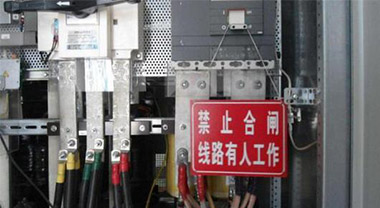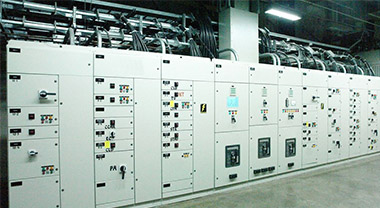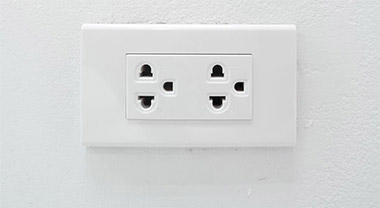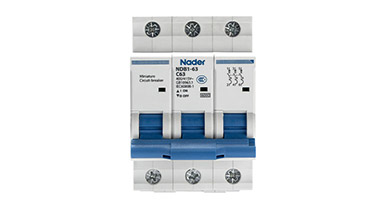High voltage circuit breaker technical parameters
The function of high-voltage circuit breaker is embodied in two aspects of control and protection. The first is the control function, which controls the use or withdrawal of electrical equipment and the operation of the line based on the actual operation needs of the power grid; the second is the protection function, and the protection object is the part of the power grid that has no operational obstacles. In the event of a failure of electrical equipment or power lines during operation, when the electrical protection automatic device issues a trip command, turn on the circuit breaker to cut off the faulty equipment and lines in a timely and accurate manner, so as to ensure that there are no faulty parts to work .
1. There are many types of high-voltage circuit breakers, and they can generally be classified as follows.
According to the arc extinguishing principle or the arc extinguishing medium of the circuit breaker, it is divided into oil circuit breakers, vacuum circuit breakers, and high sulfur fluoride (SF6) circuit breakers.
- Vacuum circuit breaker: refers to a circuit breaker that uses the high dielectric strength of vacuum to extinguish arcs.
- Hexafluoride (SP6) circuit breaker: refers to the use of hexafluoride gas with excellent insulation and arc extinguishing performance as the arc extinguishing medium and insulating medium. It can be developed into a combination of sulfur hexafluoride electrical appliances.
- In addition, high-voltage circuit breakers can be divided into indoor and outdoor types according to their installation locations.
2. The technical parameters and model meaning of high-voltage circuit breakers.
2.1 Technical parameters of high-voltage circuit breakers:
- Rated voltage: refers to the normal working voltage that the circuit breaker can withstand for a long time. It not only determines the insulation level of the circuit breaker, but also determines the overall size and arc extinguishing conditions of the circuit breaker to a considerable extent.
- Maximum working voltage: Considering that there is a voltage drop in the transmission line, the bus voltage at the power supply end of the line is higher than the bus voltage at the receiving end, so that the circuit breaker may work at a voltage higher than the rated voltage for a long time. Therefore, the circuit breaker has a maximum operating voltage. According to the common international practice, the maximum working voltage of 220kV and below equipment is 1.15 times the rated voltage; for 330kV equipment, the maximum operating voltage is 1.1 times.
- Rated current: refers to the operating current that the circuit breaker allows to pass for a long time under the rated capacity. It determines the cross-sectional area of the circuit breaker's solution head and conductive part, and to a certain extent also determines its structure. Generally, when the ambient temperature is 40°C, the rated current levels of commonly used circuit breakers are 200, 400, 630, 1000, 1250, 1600, 3150.
- Rated breaking current: It is the basis for reflecting the breaking capacity of the circuit breaker. Under the rated voltage, the maximum current that the circuit breaker can break
- Dynamic stability current: Its nickname is the limit passing current, which refers to the maximum short-circuit current value that the circuit breaker is allowed to pass when it is closed. Its existence indicates that the circuit breaker is affected by the short-circuit current and has a strong ability to withstand electrodynamic forces. weak. It is worth determining the mechanical strength of conductive and insulating components.
- Thermally stable current: refers to the maximum short-circuit current value that the circuit breaker is allowed to pass in a specified time. The thermal stability current is the ability of the circuit breaker to bear the thermal energy caused by the short-circuit current.
- Closing time: The so-called closing time is the time when the operating mechanism of the circuit breaker touches the main contact.
- Opening time: The so-called opening time is the time from when the circuit breaker receives the opening command to the separation of the arc extinguishing contacts. Generally between 0.06-0.12s. If the opening time is less than 0.06s, this type of circuit breaker is a fast circuit breaker. The inherent opening time is the time from the start of the operating mechanism to the separation of the contacts. The extinction time refers to the time from the separation of the solution head to the complete extinguishment of the arc of each phase.
2.2 The meaning of high voltage circuit breaker model:
The types of circuit breakers are: S-less oil circuit breaker; D-more oil circuit breaker; K-air circuit breaker; L-sulfur hexafluoride circuit breaker; Z-vacuum circuit breaker.
3. The basic structure and arc extinguishing process of high-voltage circuit breakers
High-voltage circuit breakers are composed of the following five parts: on-off components, intermediate transmission mechanism, operating mechanism, insulating support and base. The on-off element is the core part of the circuit breaker, and the on and off of the main circuit is completed by it. The on-off of the main circuit is transmitted to the on-off component through the middle after receiving the operation instruction by the operating mechanism, and the on-off component executes the command to make the main circuit on or off. On-off components include contacts, conductive parts, arc extinguishing medium and arc extinguishing chamber, etc., which are generally placed on an insulating support to insulate the live part from the ground, and the insulating support is installed on the base. The structure of these basic components varies with the type of circuit breaker. This article mainly introduces 10KV vacuum circuit breakers and 35KV hexafluoride circuit breakers.
3.1 Vacuum circuit breaker. The overall structure of a vacuum circuit breaker is generally divided into two types, cantilever type and floor type, and mainly consists of three parts: vacuum interrupter, bracket and operating mechanism.
The performance of the vacuum interrupter mainly depends on the contact material and structure, and is related to the structure and material of the shielding cover and the manufacturing process of the interrupter. The moving and static contacts are respectively welded to the dynamic and static conductive rods, and the bellows are used to achieve sealing . Under the action of the driving force of the mechanism, the movable contact can move axially in the arc extinguishing chamber to complete the opening and closing operations.
The contacts of the vacuum arc chamber are generally connected by magnetic blow. As shown in Figure 3-11, the middle of the contact is a "blow arc surface with three spiral grooves around the contact surface. When the contacts are closed, only the contact surfaces are in contact with each other. When the current is interrupted, the initial contact An arc is generated on the surface. Under the action of the arc magnetic field, the arc is driven to move in the tangential direction around the contact, that is, it continuously rotates on the outer edge of the contact, which prevents the arc from being fixed on the hoe and burning the contact. When the current crosses zero, the arc is It goes out.
3.2 SF6 circuit breaker.
Sulfur hexafluoride circuit breaker is abbreviated as GCB, which is a gas blown circuit breaker. Its characteristics are: the working pressure is low, during the arc blowing process, the gas is not discharged to the atmosphere, but is recycled in the sealed system. Due to the good insulation and arc extinguishing performance of SF6 gas medium, the combined GCB has the advantages of strong breaking capacity, high fracture voltage, more secondary interruptions that allow continuous breaking, low noise and no spark hazard.
SF6 circuit breaker can be divided into porcelain column type and floor tank type according to the overall structure.
- Porcelain pillar type. The arc extinguishing device is installed on the top of the supporting porcelain sleeve and operated by an insulating rod. The advantage of this structure is that it has good series. It can be assembled into products of different voltage levels by using different numbers of standard arc extinguishing units and supporting porcelain sleeves. The disadvantage is that the stability is poor and current transformers cannot be installed.
- Floor tank type. Its overall structure is similar to a multi-oil circuit breaker. Its fire arc system is supported by an insulator in the center of a grounded metal tank. With the help of a casing lead, it can be used in a fully enclosed combined electrical appliance without modification. This structure is convenient for installing current transformers, and has good anti-vibration performance, but poor series.
- Note: The high voltage GCB of 110KV and above generally has the above two structures.
- Medium-voltage GCB. There are three types of GCB for medium voltage level: rotary arc type, self-blowing type and compressed air type. In the power distribution device of 35KV and below, the overall structure of GCB is often made into a trolley type, with an appearance and a low oil and vacuum trolley switch Very similar.
SF6 circuit breaker arc extinguishing chamber has single voltage type and double voltage type, its structure and arc extinguishing process are introduced as follows:
- Single pressure type (also called compressed gas type) arc extinguishing chamber, there is only a single SF6 gas in the normal state. During the opening process, the pressure cylinder and the movable contact move at the same time to compress the gas in the compressor chamber. After the contacts are separated, the arc is blown by the high-speed airflow to extinguish the arc.
- double-pressure arc extinguishing chamber. It has two gas pressure systems, high and low pressure. The type that is filled with high pressure gas for a long time in the arc extinguishing chamber is called the constant charge high pressure type; the type that is filled with high pressure gas only during the arc combustion process is called the instantaneous charge high pressure type. When opening, the exhaust valve opens, and the high-pressure gas flows to the low-pressure area after arc blowing through the nozzle and contact. After the arc is extinguished, the exhaust valve is closed, and the compressor and the pressure monitoring system automatically maintain a constant pressure difference between the high and low pressure areas.
The double-voltage GCB has large breaking current and fast action, but the structure is complicated and the price is high. The early SF6 circuit breakers all have this structure. The single-pressure type has a simple structure, but the breaking current is small, the stroke is large, the inherent opening time is long, and the power of the operating mechanism is large. In recent years, single-voltage SF6 circuit breakers have adopted high-power hydraulic mechanisms and bidirectional arc blowing to meet technical parameter requirements and have been widely adopted.
4. The operating mechanism of the circuit breaker is a mechanism that drives the transmission mechanism of the high-voltage circuit breaker to close and open.
4.1 Basic requirements for operating mechanism:
- There should be sufficient operating power. During the closing process of the circuit breaker, the operating mechanism has to overcome a large mechanical force and electric power. Therefore, when the circuit breaker closes H, -J, the operating mechanism must emit sufficient power. The power required when the circuit breaker is opened is smaller.
- Quick action is required. It is generally required that the full opening time of fast circuit breakers is not more than 0.80s, and modern high-voltage and ultra-high voltage circuit breakers are even required to be 0.02-0.04s. In the full opening time of the circuit breaker, the inherent opening time accounts for more than 1/2, which is related to the structure of the operating mechanism.
- The operating mechanism is required to work reliably, with simple structure, small size, light weight, and convenient operation.
4.2 Types and characteristics of operating mechanism:
According to the form of energy used when the circuit breaker is closed, the operating mechanism can be divided into several types such as manual, electromagnetic, spring, pneumatic and hydraulic.
- The characteristic of the manual operating mechanism is that it is closed by manpower and has a free trip mechanism; it is simple in structure and does not require other auxiliary equipment; it is generally only used for circuit breakers whose rated breaking current does not exceed 6.3KA. Its biggest disadvantage is that the operating power is limited by manpower, the closing time is long, and the automatic reclosing cannot be realized. Currently it is rarely used.
- The electromagnetic operating mechanism uses an electromagnet to convert electrical energy into mechanical energy as the closing power. This mechanism is simple in structure, reliable in operation, and can be used for automatic reclosing and remote operation. Therefore, 10-35KV circuit breakers are currently less used and are gradually eliminated.
- The spring-type operating mechanism uses the energy stored in the spring as the closing power. This kind of mechanism has a strong complete set, does not need to be equipped with additional equipment, and consumes little power when the spring stores energy; but the structure is complex, the processing technology and material performance requirements are high, and the weight of the mechanism itself increases sharply with the increase of operating power. At present, CT7, CT8 and other series of operating mechanisms produced in our country can be used for SN10 series circuit breakers; CT6 type spring-type operating mechanism is used for SW4 series circuit breakers.
- Hydraulic operating mechanism uses compressed gas (nitrogen) as energy source and hydraulic oil as the energy transfer medium to push the movable piston to do work to close or open the circuit breaker. CY3, CY3III and CY4 hydraulic operating mechanisms have the advantages of high pressure, large output, small size, fast transmission, small delay, accurate action and relatively uniform output. Therefore, the current voltage of SF6 circuit breakers in China is 100KV and above. broadly used.
- The pneumatic operating mechanism uses compressed air to open the circuit breaker and spring force to close the circuit breaker. This kind of mechanism is simple in structure and reliable in action, and is being used more and more widely.
4.3 The main components of the operating mechanism: Generally speaking, the operating mechanism is mainly composed of the following components.
- Work and energy storage part. Its function is to convert other formed energy into institutional energy. For example, the closing electromagnet in the electromagnetic operating mechanism, after being energized, the kinetic energy of the electromagnet causes the transmission mechanism to act, and at the same time stores the energy, so that only a small amount of energy is used to release the mechanism energy when opening, so that it can be quickly opened. brake.
- Transmission system. It is used to change the direction, position, stroke and nature of the operating force. It is a set of mechanical linkage mechanism, which requires small mechanical energy loss, accurate movement and long life.
- Maintain mechanism and trip mechanism. The task of the former is to reliably keep the completed closing operation in the closed state, sometimes called "hook"; the latter is a mechanism to release the closing, which can "touch and release" to make the opening action fast , The required power is small.




